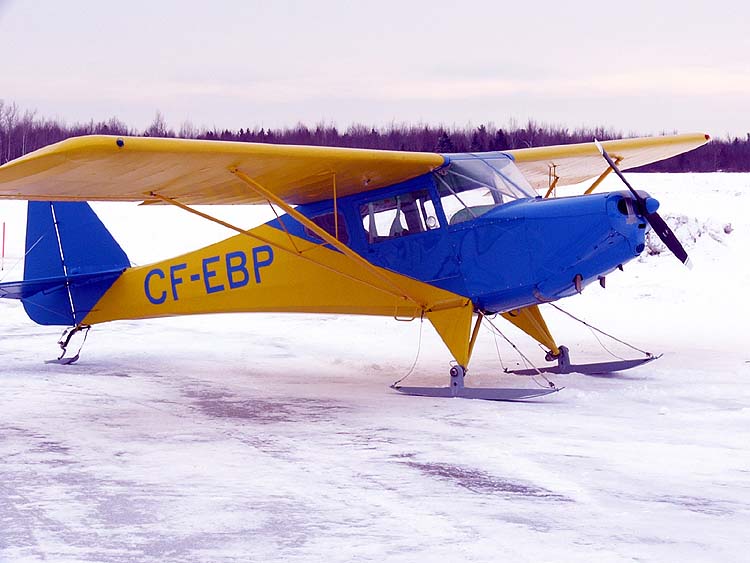- Fleet Canuck
infobox Aircraft
name =Fleet Canuck
type =trainer
manufacturer =Fleet Aircraft of Canada
caption = Fleet Canuck "CF-EPB" on straight skis
designer =J. Omer (Bob) Noury
first flight =26 September 1945 , Noury N-75 prototype flew in 1944
introduced =1946
retired =1958
status =
primary user =Flying clubs
more users =Private pilots
produced =198 (Fleet), other companies involved in production
number built =225 (including one prototype)
unit cost =$3,869.25 plus $247.63 tax [ Page and Cumming 1990, p. 118. ]
variants with their own articles =The Fleet Model 80 Canuck is a Canadian designed and built lightaircraft featuring two seats in side-by-side configuration.The Canuck was designed for the flight training, personal use and light commercial roles.
A total of 225 Canucks were built by two manufacturers during its thirteen year production run, with the majority being built by Fleet Aircraft between 1945 and 1947.
Design and development
The Canuck originated with the Noury N-75, designed by Bob Noury which first flew in 1944 at
Mount Hope, Ontario . The "home-built" N-75 was a conventional high-wingmonoplane design with a welded-steelfuselage and tail surfaces with fabric covering, looking not unlike aPiper Cub . However, the side-by-side seating in the original design was unusual for the time even though it was a far better arrangement especially for instruction than placing the instructor either in front or behind the student. Noury also experimented with a tandem-seat arrangement on a following prototype but had only built three aircraft when he sold the Noury N-75 rights to the Fleet Aircraft Company in 1945.Fleet undertook some minor design changes, principally relocating the fuel tank, adding a skylight above the cabin, lowering the front fuselage profile and replacing the original Continental C-75 with a slightly more powerful C-85 engine. The Noury N-75 was tested in its new configuration; it first flew on 26 September 1945 with Fleet Test Pilot Tommy Williams at the controls. Following modifications to the fin to increase its size, the prototype, newly renamed, emerged as the Fleet Model 80 Canuck, and entered production.
Production and use
Although the aircraft were well built, strong performers [ Page and Cumming 1990, p. 118. Note: The Fleet Canuck was capable of aerobatics due to an airframe designed to withstand 7G maneuvers.] and versatile; able to be flown with floats or skis to increase its utility, after a spurt in sales, they did not sell well. In trying to market the Fleet Canuck as either a private aircraft or a trainer, there were several obstacles:
* In the immediate postwar period, surplus ex-military aircraft were available in abundance and "sold for a song," [ [http://www.classicaircraft.ca/canuck_main.htm Fleet Canuck] ]
* Most people in the 1950s were more interested in rebuilding their careers and family lives as opposed to buying luxury items, and
* There was little interest in new training aircraft since the need for new pilots to be trained was diminished as thousands of former service pilots were looking for work.After initial sales to flying clubs, charter companies and private owners began to falter, Fleet ran into financial problems. In 1947, Canuck production by Fleet was terminated. Over the next ten years a number of aircraft were built up from components by Leavens Brothers in Toronto with total series production finishing at 224 in 1958. [ Page and Cumming 1990, p. 118. ] Several have been re-engined with the convert|100|hp|abbr=on
Continental O-200 .urvivors
Currently, there are 78 Canucks registered in Canada according to Transport Canada, although there could be more airframes existing but not registered. One Canuck, "CF-EBE", serial number 149, has been preserved at the
Canada Aviation Museum inOttawa and is in the storage building, displayed on floats. "The healthy number of surviving airframes is a testament to the sound design of a unique Canadian aircraft." [ [http://www.classicaircraft.ca/canuck_main.htm Fleet Canuck] ]In 1995, the
Royal Canadian Mint issued Coin #11, a $20 dollar silver commemorative coin in its aviation series, recognizing the Fleet 80 Canuck and its original designer, J. Omer Noury, featured in a gold-inlay cameo insert.Aircraft Type Club
The Fleet Canuck is supported by an aircraft type club, The Fleet Canuck Club.
Variants
* Fleet 80 Canuck : Two-seat sports and light touring aircraft.
* Fleet 81 : Three-seat light touring aircraft. One built.pecifications
* Manufacturer: Fleet Aircraft
* Crew/Passengers: crew of two: one pilot and passenger/trainee
* Powerplant: one convert|85|hp|abbr=on Continental C85-12J piston engine
* Dimensions
** Length: 22 ft 4.5 in (6.82 m)
** Height: 7 ft 1 in (2.1 m)
** Wing Span: 34 ft 0 in (10.3 m)
** Wing area: 173.5 sq ft (52.8 sq m)
* Weights
** Empty: 934 lb (423.65 kg)
** Gross: 1,480 lb (671.3 kg)
* Performance
** Maximum speed (wheels): 111.5 mph (178 km/h)
** Cruising speed: 93 mph (149 km/h)
** Rate of Climb: 550 ft/min (167.64 m/min)
** Service ceiling: 12,000 ft (3,657.6 m)
* Armament: NoneReferences
* Page, Ron D. and Cumming, William. "Fleet: The Flying Years". Erin, Ontario: Boston Mills Press, 1990. ISBN 1-55046-019-6.
External links
* [http://www.classicaircraft.ca/canuck_main.htm Fleet Canuck]
* [http://ato.smartcapital.ca/fleetflyers Fleet Canuck Aircraft Type Club]
Wikimedia Foundation. 2010.
